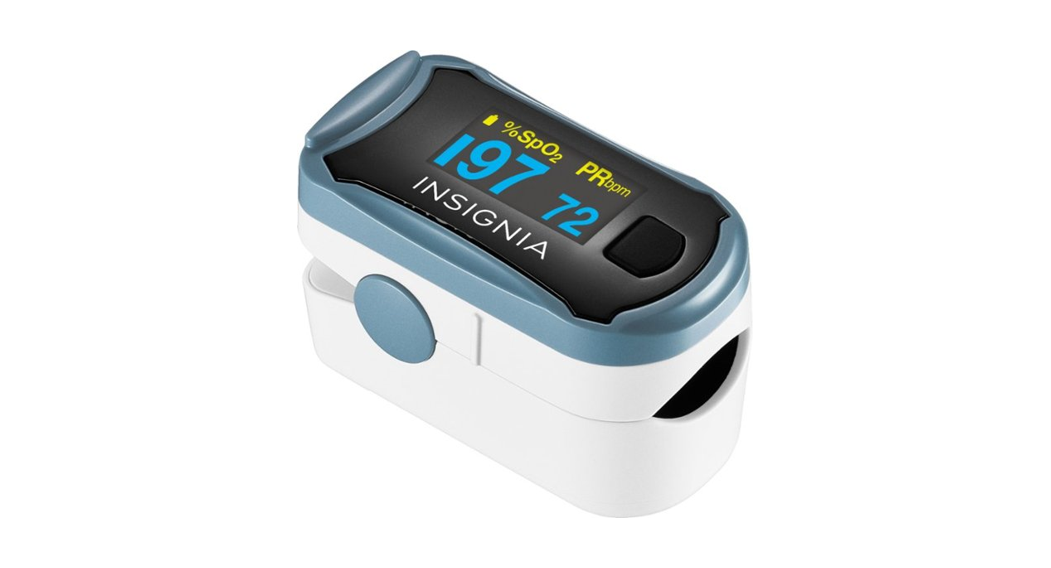 QUICK SETUP GUIDEPulse Oximeter with Digital DisplayNS-PSOXMW1
QUICK SETUP GUIDEPulse Oximeter with Digital DisplayNS-PSOXMW1
Before using your new product, please read these instructions to prevent any damage.
FEATURES
- Attaches painlessly to your finger and measures your oxygen levels and heart rate without the use of needles
- The digital display shows your results in a clear and easy-to-read format
- Compact size for easy storage and transportation
- 10 brightness levels let you read the display in dark environments
PACKAGE CONTENTS
- Pulse Oximeter
- Lanyard
- AAA batteries (2)
- Quick Setup Guide
PRODUCT OVERVIEW
| Top View | Bottom View |
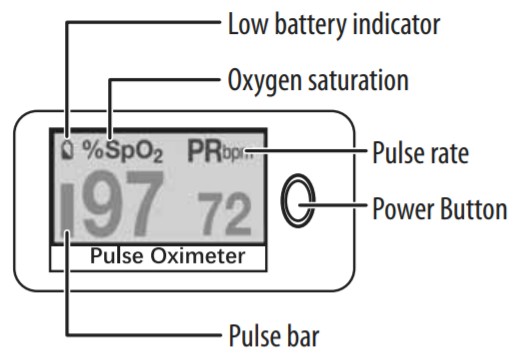  |
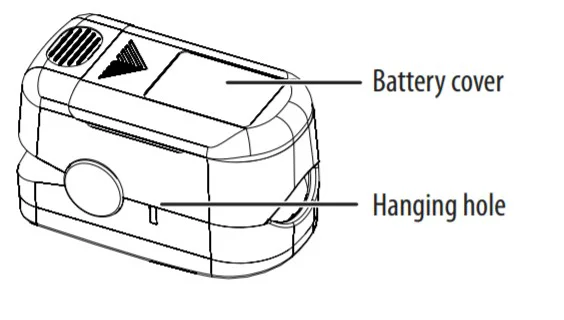  |
INSTALLING THE BATTERIES
When the battery indicator is blinking, replace the batteries.
- Slide the battery cover off.

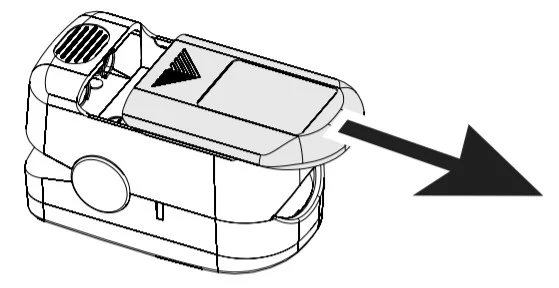
- Insert two AAA batteries into the compartment. Make sure that the + and – signs in the compartment match the batteries.

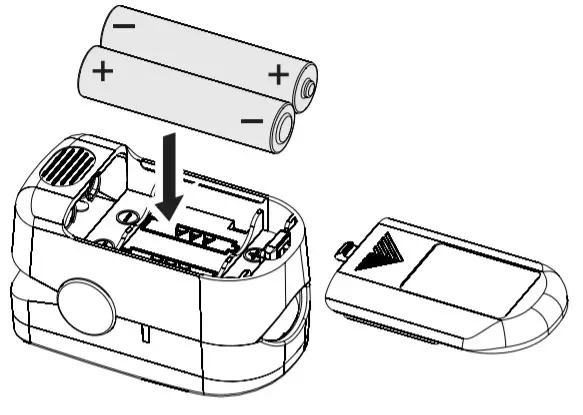
- Replace the battery cover.
Note: Remove the batteries if your pulse oximeter will not be used for long periods of time.
TAKING A READING
Note: This device is not intended to diagnose or treat any medical condition or disease. It is intended for non-medical use by healthy people to monitor their pulse rates and blood oxygen levels. It is for sports and aviation use only. People who need SpO2 and pulse rate measurements because of a medical condition should not use this pulse oximeter and should consult with their physician.
- Clean the finger being tested with alcohol before and after each test.
- Squeeze the end of your pulse oximeter and insert a finger into the opening.

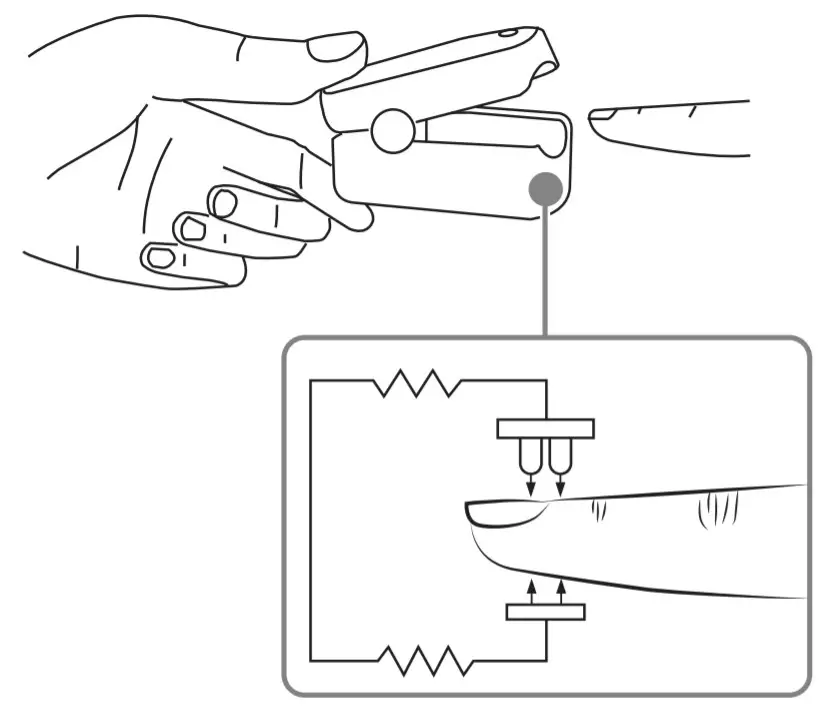
- Press the power button to turn on your pulse oximeter.
- Keep your finger, hand, and body still while your pulse oximeter takes a reading. The display shows your oxygen saturation and pulse rate.
- When you’re finished, remove your finger. Your pulse oximeter turns off automatically when there is no signal for eight seconds.
USING YOUR PULSE OXIMETER
Changing the brightnessTurn on the pulse oximeter, then press and hold the power button to adjust the display’s brightness. There are 10 brightness levels. The default is level four.Changing the display modeTurn on the pulse oximeter, then press the power button to change how the readings are displayed.There are four display modes:

Attaching the lanyard
- Thread the lanyard through the hanging hole, then pull the lanyard through the smaller loop.
- Thread the thick end of the lanyard through the threaded end before pulling it tight.

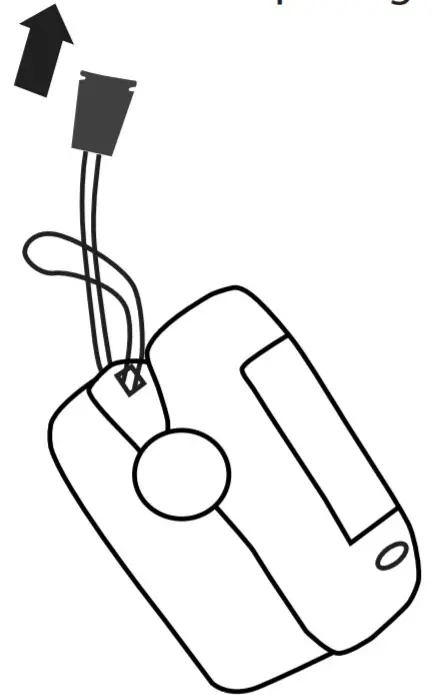
WARNINGS:
- Keep your oximeter away from young children. Small items such as the battery cover, batteries, and lanyard are choking hazards.
- The lanyard that is tied to the oximeter may cause strangulation due to excessive length.
SAFETY INFORMATION
- Carefully read all the provided information before use.
- Operation of the fingertip pulse oximeter may be affected by the use of an electrosurgical unit (ESU).
- The fingertip pulse oximeter must be able to measure the pulse properly to obtain an accurate SpO2 measurement. Make sure that nothing is hindering the pulse measurement before relying on the SpO2 measurement.
- Do not use the fingertip pulse oximeter in an MRI or CT environment.
- Do not use the fingertip pulse oximeter in situations where alarms are required. The device has no alarms. It is not for continuous monitoring.
- Do not use the fingertip pulse oximeter in an explosive atmosphere.
- The fingertip pulse oximeter is intended only as an adjunct in patient assessment. It must be used in conjunction with other methods of assessing clinical signs and symptoms.
- In order to ensure correct sensor alignment and skin integrity, the maximum application time at a single site for our device should be less than half an hour.
- Do not sterilize the device using autoclaving, ethylene oxide sterilizing, or immersing the device in liquid. The device is not intended for sterilization.
- Follow local ordinances and recycling instructions regarding disposal or recycling of the device and device components, including batteries.
- This equipment complies with IEC 60601 1 2:2014 for electromagnetic compatibility for medical electrical equipment and/or systems. However, because of the proliferation of radio frequency transmitting equipment and other sources of electrical noise in healthcare and other environments, it is possible that high levels of such interference due to close proximity or strength of a source might disrupt the performance of this device.
- Portable and mobile RF communications equipment can affect medical electrical equipment.
- This equipment is not intended for use during patient transport outside the healthcare facility.
- This equipment should not be used adjacent to or stacked with other equipment.
- It may be unsafe to:
- Use accessories, detachable parts, and materials not described in the instructions for use.• Interconnect this equipment with other equipment not described in the instructions for use.• Disassemble, repair, or modify the equipment.
- These materials that contact the patient’s skin contain medical silicone and ABS plastic enclosure and all pass the ISO10993 5 Tests for in-vitro cytotoxicity and ISO10993 10 Tests for irritation and delayed-type hypersensitivity.
- When the signal is not stable, the reading may inaccurate.Please do not reference.
MAINTENANCE & STORAGE
- Replace the batteries in a timely manner when the battery indicator is blinking.
- Clean the surface of the fingertip oximeter before it is used in diagnosis for patients.
- Remove the batteries if the oximeter is not used for a long time.
- It is best to store the product in -13°~158°F (-25°~70°C) and ≤93% humidity.
- Keep in a dry place. Extreme moisture may affect oximeter lifetime and may cause damage.
- Dispose of the batteries properly. Follow any applicable local battery disposal laws.
Cleaning the fingertip pulse oximeter
- Disinfection may cause damage to the equipment and is therefore not recommended for this pulse oximeter. If you do need to disinfect the oximeter, clean it before disinfection.CAUTION: Never use EtO or Formaldehyde for disinfection.
- Use medical alcohol to clean the silicone touching the finger inside the oximeter with a soft cloth dampened with 70% isopropyl alcohol.Note: Do not immerse the oximeter in disinfectant or sterilizer.
- Clean the finger being tested with alcohol before and after each test. The recommended disinfectants include ethanol 70%, isopropanol 70%, and glutaraldehyde type 2% liquid disinfectants.
- Do not pour or spray liquids onto the oximeter and do not allow any liquid to enter any openings in the device. Allow the oximeter to dry thoroughly before reuse.
- The pulse oximeter requires no routine calibration or maintenance other than the replacement of batteries.The useful life of the device is five years when it is used for 15 measurements every day and 10 minutes per one measurement. Stop using and contact customer service if any of the following occurs:
- “Err7” (indicating the emission LED or reception diode is damaged) is displayed on the screen.
- The oximeter won’t turn on after replacing the batteries.
- There is a crack on the oximeter or damage on the display resulting in reading that cannot be identified, the spring is invalid, or the keyis unresponsive or unavailable.
SPECIFICATIONS
Dimensions (H × W × D): 1.3 × 1.4 × 2.3 in. (34 × 36 × 58 mm)Weight (with batteries): 0.1 lbs. (50 g)Display Type: OLED displaySpO2:• Display range: 0%~100%• Measurement range: 70%~100%• Accuracy: 70%~100% ±2 %; 0%~69% no definition• Resolution: 1%Note:A functional tester can’t be used to assess the accuracy of a pulse oximeter monitor or sensor. Clinical testing is used to establish theSpO2 accuracy. The measured arterial hemoglobin saturation value(SpO2) of the sensors is compared to arterial hemoglobin oxygen(SaO2) value, determined from blood samples with a laboratoryCO-oximeter. The accuracy of the sensors in comparison to theCO-oximeter samples were measured over the SpO2 range of 70~100%.Accuracy data is calculated using the root-mean-squared (Arms value) for all subjects, per ISO 9919:2005, Medical ElectricalEquipment – Particular requirements for the basic safety and essential performance of pulse oximeter equipment for medical use.A functional tester is used to measure how accurately Fingertip PulseAn oximeter is reproducing the specified calibration curve and the PR accuracy.The model of the functional tester is the Index2 FLUKE simulator and theversion is 2.1.3.Pulse Rate
- Display range: 0 bpm~250 bpm
- Measure range: 30 bpm~250 bpm
- Accuracy: 30 bpm~99bpm, ±2 bpm; 100 bpm ~250 bpm, ±2%
- Resolution: 1bpm
Probe LED
- RED: Wavelength – 660±3nmRadiant power – 3.2mw
- IR: Wavelength – 905±10nmRadiant power – 2.4mw
Note: The information about wavelength range can be especially useful to clinicians.Power Requirements
- Two AAA alkaline batteries
- Power consumption: Less than 40 mA
Environment Requirements
- Operation Temperature: 41˚F~104˚F (5˚C~40˚C)
- Storage Temperature: -13˚F~+158˚F (-25˚C~+70˚C)
- Ambient Humidity: 15%~93% no condensation in operation; ≤93% no condensation in storage/transport
- Atmosphere pressure: 70 kPa~106 kPa
Inaccurate measurements may be caused by:
- Significant levels of dysfunctional hemoglobin (such as carbonyl hemoglobin or methemoglobin).
- Intravascular dyes such as indocyanine green or methylene blue.
- High ambient light. Shield the sensor area if necessary.
- Excessive patient movement.
- High-frequency electrosurgical interference and defibrillators.
- Venous pulsations.
- Placement of a sensor on an extremity with a blood pressure cuff, arterial catheter, or intravascular line.
- The patient has hypotension, severe vasoconstriction, severe anemia, or hypothermia.
- The patient is in cardiac arrest or is in shock.
- Fingernail polish or false fingernails.
- Weak pulse quality (low perfusion).
- Low hemoglobin.
TROUBLESHOOTING
|
PROBLEM |
POSSIBLE REASONS |
SOLUTION |
| Oxygen saturation (SpO2) or pulse rate (PR) is not normal. |
|
|
| Oxygen saturation (SpO2) or pulse rate (PR) is not stable. |
|
|
| The oximeter cannot be turned on. |
|
|
| The screen suddenly turned off. |
|
|
| “Err7” is displayed on-screen. | The emission LED or reception diode is damaged. | Contact Customer Service. |
SYMBOL DEFINITIONS
|
SYMBOL |
DEFINITION | SYMBOL |
DEFINITION |
| Type BF applied part. | Attention | ||
| Protected against dripping water | Oxygen saturation | ||
| Pulse rate (BPM) | Low power indication | ||
| No SpO2 Alarm | Serial No | ||
| Storage temperature and relative humidity | Follow instructions for use | ||
| Date of Manufacture | Manufacturer’s information | ||
| Conformity to WEEE Directive |
ONE-YEAR LIMITED WARRANTY
Visit www.insigniaproducts.com for details.



References
[xyz-ips snippet=”download-snippet”]

